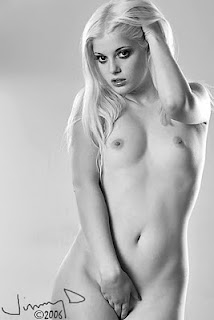 I recently purchased a book, Creative Photoshop Lighting Techniques, by Barry Huggins. Finally! One of the Photoshop gurus gets it! Whatever you're going to do with an image in post-production begins in production!
I recently purchased a book, Creative Photoshop Lighting Techniques, by Barry Huggins. Finally! One of the Photoshop gurus gets it! Whatever you're going to do with an image in post-production begins in production!This shouldn't be a secret although many photographers seem to act as if it might be.
If you're going to digitally manipulate an image in post, which nearly all of us regularly do, why wouldn't you do everything possible, while in production, to make that manipulation easier to accomplish, less obvious, and a success?
In my work, the people doing the post-processing have the ears of my clients long after I do. They can make or break me with those clients. Anything I can do in production to make their jobs easier in post, yielding better results, is not going to go unnoticed by them. It might not always be mentioned to my clients but the opposite, i.e., that I'm making their jobs more difficult, probably won't be mentioned either.
Whether you're planning to perform a great deal of digital manipulation or simply and with subtlety enhance your images, you should be thinking about post-production while you're shooting. And that includes things like lighting and composition. It especially concerns things like lighting and composition.
I can, for instance, decide in post how intense my highlights will appear only if there's something, some detail, in those highlights to work with. Once you've entirely blown all the detail out of a highlight, you're not going to recover it. You're not going to recover it with RAW converters and you're not going to recover it in Photoshop. If it's gone, it's gone. Film behaved the same way although, when it came to highlights, many film stocks were more forgiving.
The same holds true for cropping. You can crop an image in post nearly any way you want providing you've left enough negative space to do so.
The book I mentioned above, of course, isn't overly concerned with highlights or cropping. It focuses mostly on production lighting techniques to achieve certain special effects in post.
When you go to the movies and see a special effect in the film, do you think the filmmakers suddenly decided to manipulate, while in post, what they've already shot in production? Of course not. They planned the effect before beginning production and they utilized many techniques in production that would later become the raw materials for the effects.
I know most of us shooting glamour aren't often thinking of adding special effects but the point is still valid: Production contains the key ingredients to successful post-production. Post-production doesn't stand on it's own. It's not the foundation of a great image. Unless, of course, that image is purely or mostly a product of digital art.
Okay. I'm off my soapbox... for now.
The pretty girl at the top is Charlotte from 3 or 4 years ago. Captured in an empty, non-descript, 2nd floor room in a warehouse in downtown L.A. Five-foot Octo for my main. Couple of strips for kickers, either side, from behind. Flex-fill reflector in front for fill. Converted to B&W in post.

2 comments:
Hey Jimmy,
I work in film visual effects, (photography is my hobby) on the biggest films and although what you mention is the norm, where there's post production supervisors working onset and in the planning stages. There's also many times when a shot is asked to have effects added long after shooting has happened and it was hardy shot in ideal conditions.
These shots typically cost several times what they should, are not at all fun to work on and the finished product definitely suffers for it.
I'll be picking this up to help my own shooting. somewhat paradoxically, In my own photography, I prefer the light touch to retouching, rarely pushing a photo too far from what I shot in lightroom and seldomly taking it from there into photoshop.
@munkisquisher,
Yeah. I know. I've been around film/video production and post-production enough to know there's plenty of times when someone comes up with a bright idea in post to create effects that were not planned for in production. And yeah, they end up costing more and usually don't work as well as when they're planned for.
Just using the filmmaking example to encourage people to get it right in the camera. Getting it right in the camera should include post considerations. :-)
Post a Comment